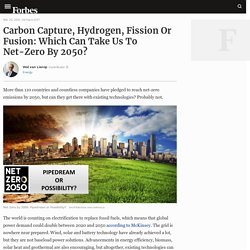

Colloque de l’AQPER - Québec affirme son intention de placer la filière éolienne au cœur de la relance économique. Comparaison des coûts totaux de possession de véhicules électriques et conventionnels au Québec – Chaire de gestion du secteur de l'énergie. Rapport d’étude de la Chaire de gestion du secteur de l’énergie – HEC Montréal Numéro 01 | 2021 Téléchargez > Résumé Ce rapport présente les résultats d’une analyse financière comparative des coûts totaux de possession ( CTP ) de 11 véhicules électriques ( VÉ ) en circulation au Québec avec leur proche équivalent à combustion interne ( VCI ), ainsi que deux modèles de camions électriques actuellement éligibles aux subventions provinciales au Québec avec leur prcohe équivalent VCI.

Le congrès printanier de CanREA s’en vient, les 28 et 29 avril. Oyez, oyez!

Pentagon scientists successfully test solar panel in space collecting energy that could one day be beamed to anywhere on Earth. The panel -- known as a Photovoltaic Radiofrequency Antenna Module (PRAM) -- was first launched in May 2020, attached to the Pentagon's X-37B unmanned drone, to harness light from the sun to convert to electricity.

The drone is looping Earth every 90 minutes. The panel is designed to make best use of the light in space, which doesn't pass through the atmosphere, and so retains the energy of blue waves, making it more powerful than the sunlight that reaches Earth. Blue light diffuses on entry into the atmosphere, which is why the sky appears blue. "We're getting a ton of extra sunlight in space just because of that," said Paul Jaffe, a co-developer of the project.
The latest experiments show that the 12x12-inch panel is capable of producing about 10 watts of energy for transmission, Jaffe told CNN. But the project envisages an array of dozens of panels and, if scaled up, its success could revolutionize both how power is generated and distributed to remote corners of the globe. It worked. Solar capacity installations in 2021 ‘could hit 209GW’ - reNews - Renewable Energy News. As much as 209GW of new photovoltaic (PV) capacity could be installed globally in 2021, according to Bloomberg New Energy Finance’s latest forecast.

BNEF’s first quarter 2021 Global PV Market Outlook predicts a minimum of 160GW of new capacity will be added in 2021, up from 141GW installed in 2020. Further out the analyst is predicting 221GW of new capacity installations in 2022 and 240GW in 2023 In other findings from its research the analyst said most country’s solar markets will grow in 2021, particularly India, which has a large number of projects delayed from 2020, and China, which is expected to maintain growth to keep course for its 2060 net zero target. To supply demand, massive expansions of polysilicon and wafer capacity are planned, along with expected new glass capacity. Carbon Capture, Hydrogen, Fission Or Fusion: Which Can Take Us To Net-Zero By 2050?
More than 110 countries and countless companies have pledged to reach net-zero emissions by 2050, but can they get there with existing technologies?

Probably not. The world is counting on electrification to replace fossil fuels, which means that global power demand could double between 2020 and 2050 according to McKinsey. The grid is nowhere near prepared. Wind, solar and battery technology have already achieved a lot, but they are not baseload power solutions. Advancements in energy efficiency, biomass, solar heat and geothermal are also encouraging, but altogether, existing technologies can neutralize 50% to 60% of carbon emissions, at best.
But the net-zero equation is complex. In the hard-to-abate industries that require heat and steam power, the situation is even more complicated. Let’s consider the four options that have garnered the most attention: 1. Blue Vs. Green Hydrogen: Which Will The Market Choose? As U.S regulators and industry leaders mull how to consider introducing hydrogen into the nation’s energy supply mix, they’re faced with a choice that sounds more like a decision pondered by the hosts of one of TV’s many home fixer-upper shows – should they go with blue hydrogen or green hydrogen, and what combination of the two will create the right mix?

The answers to those questions will likely have a great impact on the speed with which the U.S. economy makes the transition to a zero-carbon future and the cost of getting there. Today about 99% of the hydrogen produced for industrial use – in refineries and manufacturing plants – is so-called “gray” hydrogen. Gray hydrogen principally is derived from natural gas, and its production results in the production of large volumes of CO₂, nine parts CO₂ for every one part hydrogen.
Green hydrogen on the other hand is produced via electrolysis, the process of separating water into hydrogen and oxygen. Hydrogen Deployment Accelerating with More Than $300 Billion in Project Pipeline; Including $80 Billion in Mature Projects - Hydrogen Council. Skip to content.

Le bitcoin, plus énergivore qu’un pays. Pour la première fois, en 2020, le monde a plus investi dans les énergies vertes que dans les fossiles. Pas toujours facile de trouver les signes du fameux monde d’après, né de la pandémie mondiale et de la mise à l’arrêt de l’économie.

Le bilan énergétique mondial, que livre annuellement l’Institut français du pétrole Énergies nouvelles (IFPEN) et présenté le 16 février, en donne pourtant un aperçu.